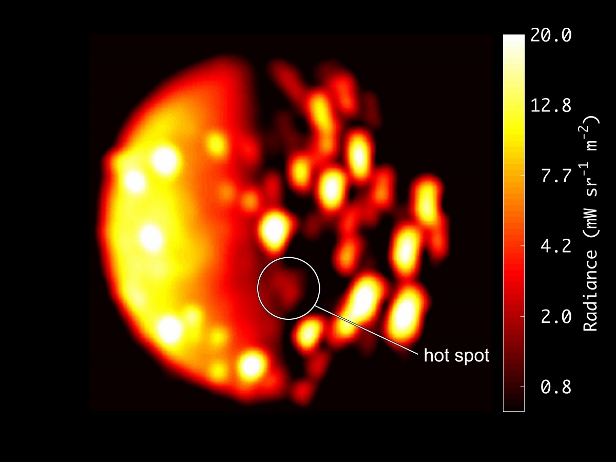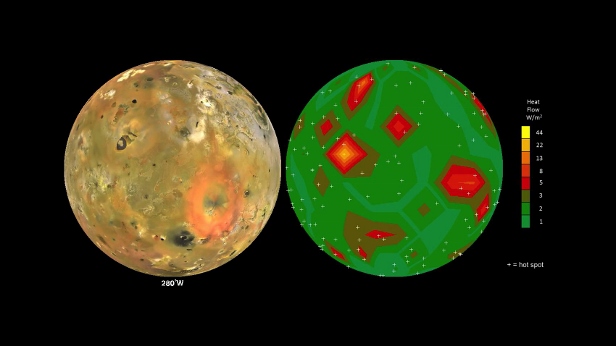Another volcano candidate spotted on Io
Recent images taken from NASA’s Juno spacecraft show the possible presence of another volcano on the surface

An annotated image highlights the location of the new heat source close to the south pole of Io. The scale to the right of image depicts of the range of temperatures displayed in the infrared image. Higher recorded temperatures are characterized in brighter colours – lower temperatures in darker colours. Image credit: NASA/JPL-Caltech/SwRI/ASI/INAF/JIRAM
Data collected by NASA’s Juno spacecraft using its Jovian InfraRed Auroral Mapper (JIRAM) instrument point to a new heat source close to the south pole of Io that could indicate a previously undiscovered volcano on the small moon of Jupiter. The infrared data were collected on 16 December 2017, when Juno was about 470,000 kilometres (290,000 miles) away from the moon.
“The new Io hotspot JIRAM picked up is about 200 miles (300 kilometres) from the nearest previously mapped hotspot,” says Alessandro Mura, a Juno co-investigator from the National Institute for Astrophysics in Rome, Italy. “We are not ruling out movement or modification of a previously discovered hot spot, but it is difficult to imagine one could travel such a distance and still be considered the same feature.”
The Juno team will continue to evaluate data collected on the 16 December flyby, as well as JIRAM data that will be collected during future (and even closer) flybys of Io. Past NASA missions of exploration that have visited the Jovian system (Voyagers 1 and 2, Galileo, Cassini and New Horizons), along with ground-based observations, have located over 150 active volcanoes on Io so far. Scientists estimate that about another 250 or so are waiting to be discovered.

Jupiter’s volcanic moon Io as seen by NASA’s Voyager and Galileo spacecraft (at left) and the pattern of heat flow from 242 active volcanoes (at right). The red and yellow areas are places where local heat flow is greatest – the result of magma erupting from Io’s molten interior onto the surface. Image credit: NASA/JPL-Caltech/Bear Fight Institute
Juno has logged nearly 235 million kilometres (146 million miles) since entering Jupiter’s orbit on 4 July 2016. Juno’s 13th science pass will be on 16 July 2018.
Juno launched on 5 August 2011, from Cape Canaveral, Florida. During its mission of exploration, Juno soars low over the planet’s cloud tops – as close as about 3,400 kilometres (2,100 miles). During these flybys, Juno is probing beneath the obscuring cloud cover of Jupiter and studying its auroras to learn more about the planet’s origins, structure, atmosphere and magnetosphere.
NASA’s Jet Propulsion Laboratory (JPL) manages the Juno mission for the principal investigator, Scott Bolton, of Southwest Research Institute in San Antonio, United Staes. The Juno mission is part of the New Frontiers Program managed by NASA’s Marshall Space Flight Centre in Huntsville, Alabama, United States, for the Science Mission Directorate. The Italian Space Agency (ASI), contributed two instruments, a Ka-band frequency translator (KaT) and the Jovian Infrared Auroral Mapper (JIRAM). Lockheed Martin Space, Denver, built the spacecraft. JPL is a division of Caltech in Pasadena, California, United States.
Keep up to date with the latest reviews in All About Space – available every month for just £4.99. Alternatively you can subscribe here for a fraction of the price!




